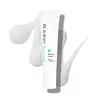What's inside
What's inside
 Key Ingredients
Key Ingredients

 Benefits
Benefits

 Concerns
Concerns

 Ingredients Side-by-side
Ingredients Side-by-side

Water
Skin ConditioningGlycerin
HumectantButylene Glycol
HumectantCaprylic/Capric Triglyceride
MaskingNiacinamide
SmoothingPanthenol
Skin ConditioningSqualane
EmollientAloe Barbadensis Leaf Juice
Skin ConditioningGlyceryl Stearate
EmollientButyrospermum Parkii Butter
Skin ConditioningHydrogenated Olive Oil Stearyl Esters
Emulsion StabilisingCucumis Sativus Fruit
Skin ConditioningCucumis Sativus Fruit Extract
EmollientAvena Sativa Kernel Extract
AbrasiveCalendula Officinalis Extract
Skin ConditioningCetearyl Alcohol
EmollientLavandula Angustifolia Flower Water
Skin ConditioningCarbomer
Emulsion StabilisingTromethamine
BufferingDipropylene Glycol
HumectantCaprylyl Glycol
EmollientEthylhexyl Olivate
Skin ConditioningHydroxyacetophenone
AntioxidantHydrolyzed Dna
Skin ConditioningSodium Acrylates Copolymer
Ceramide NP
Skin Conditioning1,2-Hexanediol
Skin ConditioningPolyglyceryl-4 Oleate
EmulsifyingAcrylates/C10-30 Alkyl Acrylate Crosspolymer
Emulsion StabilisingHydrolyzed Hyaluronic Acid
HumectantDisodium EDTA
Adenosine
Skin ConditioningLaminaria Ochroleuca Extract
Skin ConditioningCholesterol
EmollientHydrogenated Ethylhexyl Olivate
EmollientPalmitic Acid
EmollientHydrogenated Olive Oil Unsaponifiables
EmollientDipotassium Glycyrrhizate
HumectantWater, Glycerin, Butylene Glycol, Caprylic/Capric Triglyceride, Niacinamide, Panthenol, Squalane, Aloe Barbadensis Leaf Juice, Glyceryl Stearate, Butyrospermum Parkii Butter, Hydrogenated Olive Oil Stearyl Esters, Cucumis Sativus Fruit, Cucumis Sativus Fruit Extract, Avena Sativa Kernel Extract, Calendula Officinalis Extract, Cetearyl Alcohol, Lavandula Angustifolia Flower Water, Carbomer, Tromethamine, Dipropylene Glycol, Caprylyl Glycol, Ethylhexyl Olivate, Hydroxyacetophenone, Hydrolyzed Dna, Sodium Acrylates Copolymer, Ceramide NP, 1,2-Hexanediol, Polyglyceryl-4 Oleate, Acrylates/C10-30 Alkyl Acrylate Crosspolymer, Hydrolyzed Hyaluronic Acid, Disodium EDTA, Adenosine, Laminaria Ochroleuca Extract, Cholesterol, Hydrogenated Ethylhexyl Olivate, Palmitic Acid, Hydrogenated Olive Oil Unsaponifiables, Dipotassium Glycyrrhizate
Water
Skin ConditioningNiacinamide
SmoothingAlcohol Denat.
AntimicrobialButylene Glycol
HumectantBetaine
HumectantAmylopectin
Dimethylimidazolidinone Rice Starch
AbsorbentRosa Canina Fruit Extract
AstringentAgrimonia Eupatoria Extract
AstringentFucus Vesiculosus Extract
EmollientFumaria Officinalis Extract
Skin ConditioningNasturtium Officinale Extract
PerfumingPanax Ginseng Root Extract
EmollientRosmarinus Officinalis Leaf Extract
AntimicrobialScrophularia Nodosa Extract
Skin ConditioningUrtica Dioica Leaf Extract
Skin ConditioningPanthenol
Skin ConditioningSphingomonas Ferment Extract
Skin ConditioningBiosaccharide Gum-1
HumectantSorbitol
HumectantXanthan Gum
EmulsifyingAmylose
HumectantMicrocrystalline Cellulose
AbsorbentCellulose Gum
Emulsion StabilisingEthylhexylglycerin
Skin ConditioningCitric Acid
BufferingPantolactone
HumectantPhenoxyethanol
PreservativeWater, Niacinamide, Alcohol Denat., Butylene Glycol, Betaine, Amylopectin, Dimethylimidazolidinone Rice Starch, Rosa Canina Fruit Extract, Agrimonia Eupatoria Extract, Fucus Vesiculosus Extract, Fumaria Officinalis Extract, Nasturtium Officinale Extract, Panax Ginseng Root Extract, Rosmarinus Officinalis Leaf Extract, Scrophularia Nodosa Extract, Urtica Dioica Leaf Extract, Panthenol, Sphingomonas Ferment Extract, Biosaccharide Gum-1, Sorbitol, Xanthan Gum, Amylose, Microcrystalline Cellulose, Cellulose Gum, Ethylhexylglycerin, Citric Acid, Pantolactone, Phenoxyethanol
Ingredients Explained
These ingredients are found in both products.
Ingredients higher up in an ingredient list are typically present in a larger amount.
Butylene Glycol (or BG) is used within cosmetic products for a few different reasons:
Overall, Butylene Glycol is a safe and well-rounded ingredient that works well with other ingredients.
Though this ingredient works well with most skin types, some people with sensitive skin may experience a reaction such as allergic rashes, closed comedones, or itchiness.
Learn more about Butylene GlycolNiacinamide is a multitasking form of vitamin B3 that strengthens the skin barrier, reduces pores and dark spots, regulates oil, and improves signs of aging.
And the best part? It's gentle and well-tolerated by most skin types, including sensitive and reactive skin.
You might have heard of "niacin flush", or the reddening of skin that causes itchiness. Niacinamide has not been found to cause this.
In very rare cases, some individuals may not be able to tolerate niacinamide at all or experience an allergic reaction to it.
If you are experiencing flaking, irritation, and dryness with this ingredient, be sure to double check all your products as this ingredient can be found in all categories of skincare.
When incorporating niacinamide into your routine, look out for concentration amounts. Typically, 5% niacinamide provides benefits such as fading dark spots. However, if you have sensitive skin, it is better to begin with a smaller concentration.
When you apply niacinamide to your skin, your body converts it into nicotinamide adenine dinucleotide (NAD). NAD is an essential coenzyme that is already found in your cells as "fuel" and powers countless biological processes.
In your skin, NAD helps repair cell damage, produce new healthy cells, support collagen production, strengthen the skin barrier, and fight environmental stressors (like UV and pollution).
Our natural NAD levels start to decline with age, leading to slower skin repair, visible aging, and a weaker skin barrier. By providing your skin niacinamide, you're recharging your skin's NAD levels. This leads to stronger, healthier, and younger looking skin.
Another name for vitamin B3 is nicotinamide. This vitamin is water-soluble and our bodies don't store it. We obtain Vitamin B3 from either food or skincare. Meat, fish, wheat, yeast, and leafy greens contain vitamin B3.
The type of niacinamide used in skincare is synthetically created.
Learn more about NiacinamidePanthenol is a common ingredient that helps hydrate and soothe the skin. It is found naturally in our skin and hair.
There are two forms of panthenol: D and L.
D-panthenol is also known as dexpanthenol. Most cosmetics use dexpanthenol or a mixture of D and L-panthenol.
Panthenol is famous due to its ability to go deeper into the skin's layers. Using this ingredient has numerous pros (and no cons):
Like hyaluronic acid, panthenol is a humectant. Humectants are able to bind and hold large amounts of water to keep skin hydrated.
This ingredient works well for wound healing. It works by increasing tissue in the wound and helps close open wounds.
Once oxidized, panthenol converts to pantothenic acid. Panthothenic acid is found in all living cells.
This ingredient is also referred to as pro-vitamin B5.
Learn more about PanthenolWater. It's the most common cosmetic ingredient of all. You'll usually see it at the top of ingredient lists, meaning that it makes up the largest part of the product.
So why is it so popular? Water most often acts as a solvent - this means that it helps dissolve other ingredients into the formulation.
You'll also recognize water as that liquid we all need to stay alive. If you see this, drink a glass of water. Stay hydrated!
Learn more about Water